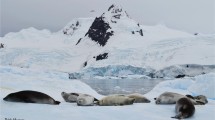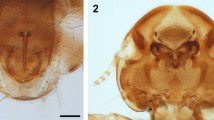Abstract
Among Anoplura, the family Echinophthiriidae includes those species that infest mainly the pinnipeds. Working with large hosts implies methodological considerations as the time spent in the sampling, and the way in that the animal is restrained. Previous works on echinophthiriids combined a diverse array of analyses including field counts of lice and in vitro observations. To collect lice, the authors used forceps, and each louse was collected individually. This implied a long manipulation time, i.e., ≈60 min and the need to physically and/or chemically immobilize the animal. The present work described and discussed for the first a sample technique that minimized the manipulation time and also avoiding the use of anesthesia. This methodology implied combing the host’s pelage with a fine-tooth plastic comb, as used in the treatment of human pediculosis, and keeping the comb with the lice retained in a Ziploc® bag with ethanol. This technique was used successfully in studies of population dynamic, habitat selection, and transmission pattern, being a reliable methodology. Lice are collected entirely and are in a good condition to prepare them for mounting for studying under light or scanning electron microscopy. Moreover, the use of the plastic comb protects from damaging taxonomically important structures as spines being also recommended to reach taxonomic or morphological goals.



Similar content being viewed by others
References
Aznar FJ, Leonardi MS, Berón-Vera B, Vales DG, Ameghino S, Raga JA, Crespo EA (2009) Population dynamics of Antarctophthirus microchir (Anoplura: Echinophthiriidae) in pups from South American sea lion, Otaria flavescens, in Northern Patagonia. Parasitology 136:293–303
Bush AO, Lafferty KD, Lotz JM, Shostak AW (1997) Parasitology meets ecology on its own terms: Margolis et al. revisited. J Parasitol 83:575–583
Clayton DH, Drown DM (2001) Critical evaluation of five methods for quantifying chewing lice (Insecta: Phthiraptera). J Parasitol 87:1291–1300
Durden LA, Musser GG (1994) The sucking lice (Insecta, Anoplura) of the world: a taxonomic checklist with records of mammalian hosts and geographical distributions. Bull Am Mus Nat Hist 218:1–90
Gales N, Brennan A, Baker R (2006) Ethics and marine mammal research. In: Marine mammals: fisheries, tourism and management issues. In: Gales N, Hindell M, Kirkwood R (Eds) CSIRO Publishing, pp 321–329
Gales N, Bowen WD, Johnston DW, Kovacs KM, Littnan CL, Perrin WF, Reynolds JE III, Thompson PM (2009) Guidelines for the treatment of marine mammals in field research. Mar Mammal Sci 25:725–736
Gallardo A, Toloza A, Vassena C, Picollo MI, Mougabure-Cueto G (2013) Comparative efficacy of commercial combs in removing head lice (Pediculus humanus capitis) (Phthiraptera: Pediculidae). Parasitol Res 112:1363–1366
Halliday T (1995) More on toe-clipping. Froglog 12:3
Kim KC (1972) Louse populations of the northern fur seal (Callorhinus ursinus). Am J Vet Res 33:2027–2036
Kim KC (1975) Ecology and morphological adaptation of the sucking lice (Anoplura, Echinophthiriidae) on the northern fur seal. Rapp P-V Réun Cons Int Explor Mer 169:504–515
Laws RM (1993) Development of technology and research needs. In: Laws RM (ed) Antarctic seals: Research methods and techniques. Cambridge University Press, Cambridge
Leonardi MS (2007) Dinámica poblacional de Antarctophthirus microchir (Anoplura, Echinophthiriidae) en crías de lobo marino de un pelo, en el norte de Patagonia. Argentina. Degree thesis. Universidad Nacional de Mar del Plata, Argentina
Leonardi MS (2014) Coadaptación entre Antarctophthirus microchir (Anoplura: Echinophthiriidae) y el lobo marino de un pelo (Otaria flavescens) y sus implancias en la morfología, ciclo reproductivo y dinámica poblacional del parásito. Phd Thesis. Universidad Nacional de Mar del Plata. 160 pp
Leonardi MS, Crespo EA, Raga JA, Fernández M (2009) Redescription of Antarctophthirus microchir, Trouessart & Neumman 1888 (Anoplura: Echinophthiriidae) from the South American sea lion, Otaria flavescens, from Patagonia, Argentina. J Parasitol 95:1086–1092
Leonardi MS, Crespo EA, Raga JA, Fernández M (2012a) Scanning electron microscopy of Antarctophthirus microchir (Phthiraptera: Anoplura: Echinophthiriidae): studying morphological adaptations to aquatic life. Micrones 43:929–936
Leonardi MS, Crespo EA, Vales DG, Feijoo M, Raga JA, Aznar FJ (2012b) Life begins when the sea lion is ashore: Microhabitat use by a louse living on a diving mammal host. B Entomol Res 102:444–452
Leonardi MS, Crespo EA, Raga JA, Aznar FJ (2013) Lousy mums: patterns of vertical transmission of an amphibious louse. Parasitol Res 112:3315–3323
Mehlhorn B, Mehlhorn H, Plötz J (2002) Light and scanning electron microscopical study on Antarctophthirus ogmorhini lice from the Antarctic seal Leptonychotes weddelli. Parasitol Res 88:651–660
Murray MD, Nicholls DG (1965) Studies on the ectoparasites of seals and penguins. I. The ecology of the louse Lepidophthirus macrorhini Enderlein on the southern elephant seal, Mirounga leonina (L.). Aust J Zool 13:437–454
Murray MD, Smith MSR, Soucek Z (1965) Studies on the ectoparasites of seals and penguins. II. The ecology of the louse Antarctophthirus ogmorhini Enderlein on the Weddell seal, Leptonychotes weddelli Lesson. Aust J Zool 13:761–771
Powell RA, Proulx G (2003) Trapping and marking terrestrial mammals for research: Integrating ethics, performance criteria, techniques, and common sense. ILAR J 44:259–276
Rand RW (1950) Branding in field-work on seals. J Wildl Manage 14:128–132
Reiczigel J, Rózsa L (2005) Quantitative Parasitology 3.0. Budapest. In: D.b.t. (ed)
Rózsa L, Reiczigel J, Majoros G (2000) Quantifying parasites in samples of hosts. J Parasitol 86:228–232
Stirling I (1966) A technique for handling live seals. J Mammal 47:543–544
Zar JH (1994) Biostatistical analysis. Prentice- Hall, New Jersey
Acknowledgments
The author thanks D. Vales, M. Feijoo, M. Degrati, N.A. García, G. Giardino, M.F. Grandi, M.J. Klaich, A. Mandiola, and L. Silva for their invaluable assistance in the fieldwork. Institutional and logistic support was given by Centro Nacional Patagónico (CONICET, Argentina) under permits of the Secretaría de Áreas Protegidas y Turismo and the Dirección de Fauna y Flora Silvestre, Chubut Province (Argentina). For comments on earlier versions of the manuscript, the author is grateful to Carlos Rumbold and Dr. Cynthia Awruch. Thanks are given to the Ministerio de Ciencia, Tecnología e Innovación Productiva de la Nación for the promotion of the scientific Argentinean program and the support to public education.
Author information
Authors and Affiliations
Corresponding author
Rights and permissions
About this article
Cite this article
Leonardi, M.S. Faster the better: a reliable technique to sample anopluran lice in large hosts. Parasitol Res 113, 2015–2018 (2014). https://doi.org/10.1007/s00436-014-3890-0
Received:
Accepted:
Published:
Issue Date:
DOI: https://doi.org/10.1007/s00436-014-3890-0




